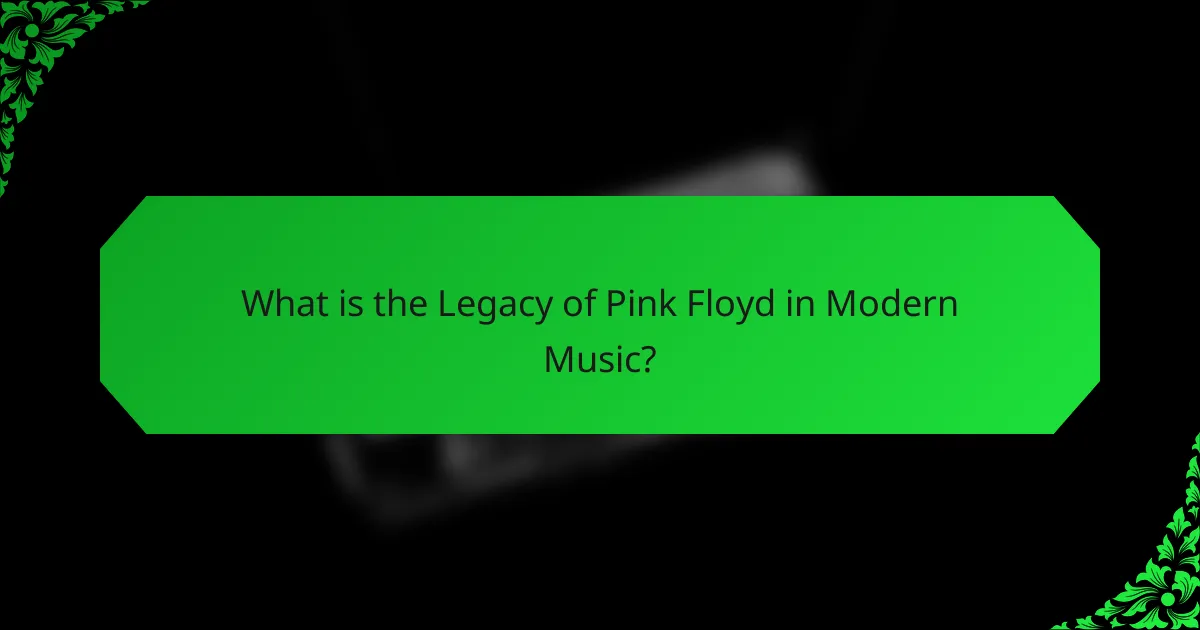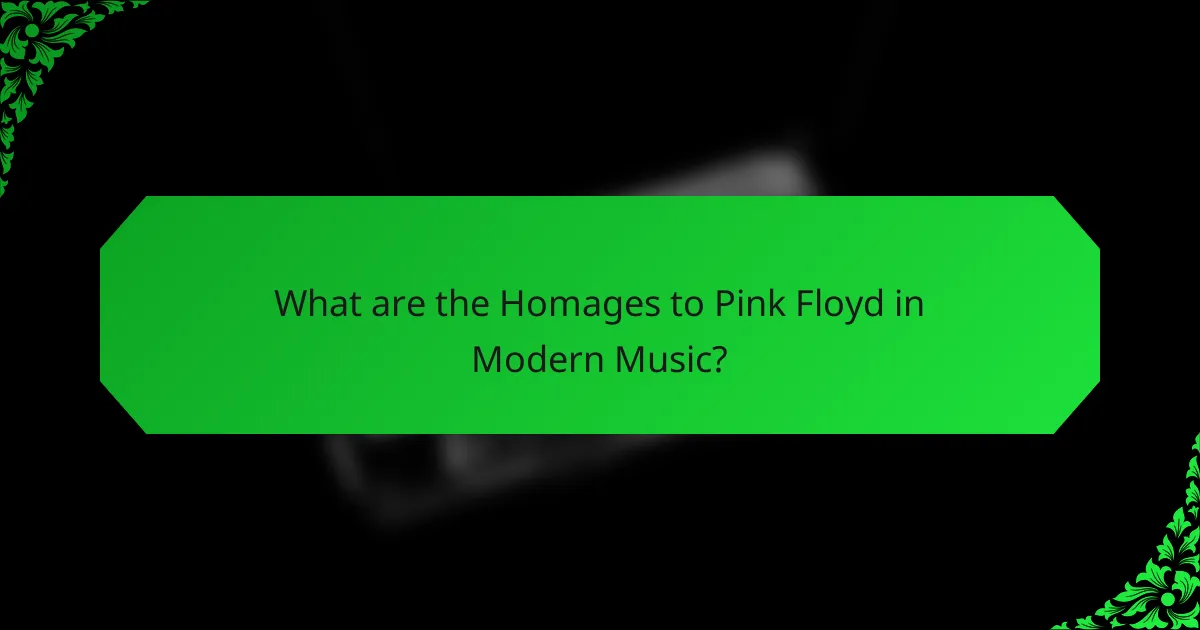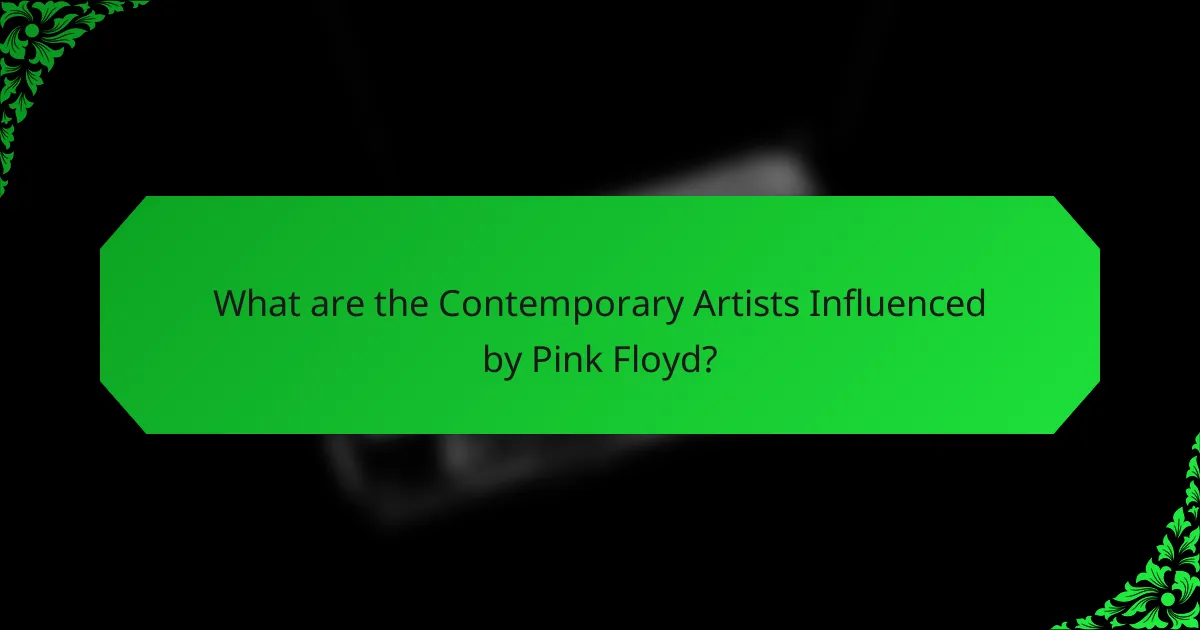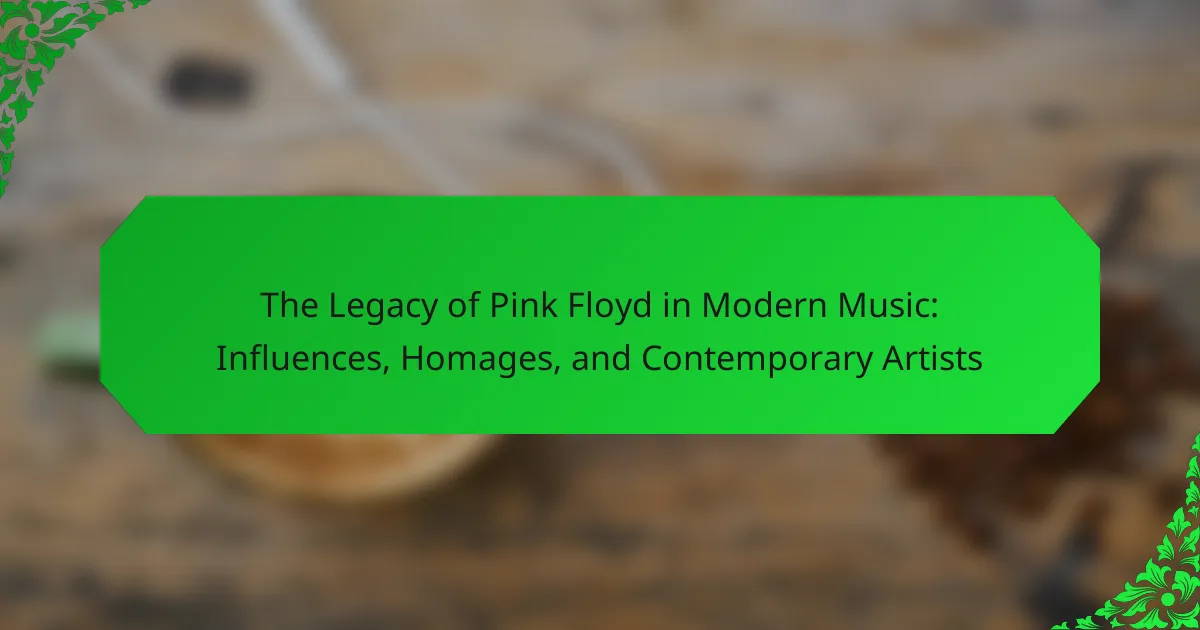Pink Floyd is a seminal rock band whose innovative sound and conceptual albums have left a lasting legacy in modern music. Their iconic works, such as “The Dark Side of the Moon” and “The Wall,” have influenced a wide range of genres, including rock, pop, and electronic music, by introducing narrative-driven themes and advanced production techniques. Numerous contemporary artists, including Radiohead, Tame Impala, and Muse, draw inspiration from Pink Floyd’s atmospheric soundscapes and thematic explorations of alienation and societal issues. The band’s integration of music and visual art has also shaped modern music videos and live performances, underscoring their profound impact on today’s musical landscape.

What is the Legacy of Pink Floyd in Modern Music?
Pink Floyd’s legacy in modern music is profound and far-reaching. Their innovative sound and conceptual albums have shaped various genres. Albums like “The Dark Side of the Moon” and “The Wall” introduced narrative-driven music. These works influenced artists across rock, pop, and electronic genres. Many contemporary musicians cite Pink Floyd as a major inspiration. Their use of synthesizers and studio effects set new standards for production. Additionally, their exploration of themes like alienation resonates with today’s artists. Pink Floyd’s impact is evident in the music of bands like Radiohead and Muse. Their ability to blend music with visual art has also influenced modern music videos.
How has Pink Floyd influenced contemporary music genres?
Pink Floyd has significantly influenced contemporary music genres through their innovative soundscapes and conceptual albums. Their use of synthesizers and experimental sounds paved the way for electronic music. The band’s emphasis on narrative and thematic coherence in albums inspired progressive rock and art rock movements. Notable contemporary artists, such as Radiohead and Muse, cite Pink Floyd as a major influence. Their album “The Dark Side of the Moon” remains a benchmark for sonic experimentation and production quality. This album’s impact is evident in the work of many modern artists who seek to create immersive listening experiences. Additionally, Pink Floyd’s exploration of existential themes resonates in today’s music, influencing genres like alternative and indie rock. Their legacy continues to shape the boundaries of music creativity and expression today.
What are the key musical elements that define Pink Floyd’s sound?
Pink Floyd’s sound is defined by several key musical elements. These include atmospheric soundscapes, complex song structures, and philosophical lyrics. Their use of synthesizers and innovative studio techniques contributes to a unique audio experience. The band often incorporates extended instrumental sections, blending rock, jazz, and electronic music. Additionally, they utilize concept albums to create cohesive narratives. Their signature use of reverb and delay effects enhances the immersive quality of their music. Iconic tracks like “Comfortably Numb” and “Wish You Were Here” exemplify these elements. The band’s influence on progressive rock and modern music is profound and enduring.
How do Pink Floyd’s themes resonate with modern artists?
Pink Floyd’s themes resonate with modern artists through their exploration of existentialism, alienation, and societal critique. These themes reflect contemporary issues such as mental health, political unrest, and the human condition. Many modern musicians cite Pink Floyd as an influence, particularly in their use of soundscapes and conceptual albums. For instance, artists like Radiohead and Tool incorporate similar introspective lyrics and atmospheric elements in their music. The emotional depth found in Pink Floyd’s work encourages modern artists to address complex themes in their own compositions. Additionally, the band’s innovative use of technology in music production inspires contemporary artists to experiment with sound.
Why is Pink Floyd considered a pivotal band in music history?
Pink Floyd is considered a pivotal band in music history due to their innovative approach to music and album production. They pioneered the concept album format, which tells a cohesive story through interconnected tracks. Their 1973 album “The Dark Side of the Moon” is one of the best-selling albums of all time, showcasing their unique blend of rock, psychedelia, and progressive elements. The band also incorporated elaborate live shows, featuring visual effects and storytelling, which set a new standard for concert experiences. Their exploration of complex themes, such as mental illness, war, and existentialism, resonated with audiences, influencing countless artists across genres. Pink Floyd’s impact is evident in the way they shaped the sound and style of modern rock music. Their legacy continues to inspire contemporary musicians and is reflected in numerous tributes and homages.
What cultural movements did Pink Floyd impact?
Pink Floyd impacted several cultural movements, notably the counterculture of the 1960s and 1970s. Their music resonated with anti-establishment sentiments and the quest for personal freedom. The band’s use of psychedelic sounds was influential in the psychedelic rock movement. Their concept albums, particularly “The Dark Side of the Moon,” contributed to the progressive rock genre. Pink Floyd’s theatrical live performances shaped the development of rock concerts into immersive experiences. Their exploration of themes like alienation and mental health influenced the art and music of the post-punk movement. Additionally, their visual art and album covers set new standards in the intersection of music and visual culture.
How has the band’s discography shaped the music industry?
Pink Floyd’s discography has significantly shaped the music industry by pioneering progressive rock and concept albums. Their album “The Dark Side of the Moon” revolutionized album production and sales, remaining on the Billboard charts for 741 weeks. The band’s integration of elaborate soundscapes and philosophical lyrics set new standards for artistic expression in music. Their use of technology, such as synthesizers and advanced studio techniques, influenced countless artists and genres. Pink Floyd’s emphasis on thematic continuity in albums has inspired the creation of cohesive works in various music styles. Their impact is evident in the rise of the rock opera format, influencing bands like The Who and contemporary artists. The band’s live performances redefined concert experiences, incorporating visual elements that are now standard in the industry. Overall, Pink Floyd’s innovative approach has left a lasting legacy on music production, performance, and artistic integrity.

What are the Homages to Pink Floyd in Modern Music?
Numerous modern artists have paid homage to Pink Floyd in their music. For instance, Radiohead has drawn inspiration from Pink Floyd’s atmospheric soundscapes. Their album “OK Computer” showcases similar themes of alienation and dystopia. Additionally, The 1975’s song “Love It If We Made It” reflects Pink Floyd’s critique of societal issues. The band often incorporates elaborate visual elements in their performances, reminiscent of Pink Floyd’s theatrical shows. Furthermore, artists like Muse have cited Pink Floyd as a significant influence on their progressive rock style. Their use of grandiose instrumentation and conceptual themes echoes Pink Floyd’s legacy. These examples illustrate the lasting impact of Pink Floyd on contemporary music.
Which contemporary artists have paid tribute to Pink Floyd?
Contemporary artists who have paid tribute to Pink Floyd include Radiohead, Muse, and The Flaming Lips. Radiohead often incorporates experimental sounds reminiscent of Pink Floyd’s style. Muse has cited Pink Floyd as a major influence on their music and live performances. The Flaming Lips have covered Pink Floyd songs and referenced their themes in their work. These artists showcase Pink Floyd’s lasting impact on modern music through their homage and inspiration.
What specific songs or albums reference Pink Floyd’s work?
Numerous songs and albums reference Pink Floyd’s work. Notable examples include “The Final Cut” by Roger Waters, which directly alludes to themes from Pink Floyd’s discography. The band Radiohead has acknowledged Pink Floyd’s influence, particularly in their album “OK Computer.” The song “Wish You Were Here” by Incubus pays homage to Pink Floyd’s classic track of the same name. Additionally, the album “The Dark Side of the Moon” has inspired artists like The Smashing Pumpkins and their work in “Mellon Collie and the Infinite Sadness.” These references highlight Pink Floyd’s lasting impact on contemporary music.
How do these tributes reflect Pink Floyd’s influence?
Tributes to Pink Floyd reflect the band’s profound influence on music and culture. Many contemporary artists cite Pink Floyd as a key inspiration for their sound and artistic vision. For example, bands like Radiohead and Muse incorporate atmospheric elements reminiscent of Pink Floyd’s style. The use of conceptual themes in their albums mirrors the narrative depth found in Pink Floyd’s work. Additionally, tribute concerts often feature elaborate visual presentations, echoing Pink Floyd’s iconic stage shows. These tributes celebrate the band’s innovative approach to music production and storytelling. They also highlight Pink Floyd’s impact on the progressive rock genre. Overall, these tributes serve as a testament to the enduring legacy of Pink Floyd in modern music.
Why do artists feel inspired to honor Pink Floyd?
Artists feel inspired to honor Pink Floyd due to their profound impact on music and culture. The band’s innovative sound and conceptual albums reshaped rock music. Their exploration of themes like alienation and existentialism resonates with many. Pink Floyd’s use of technology in music production set new standards in the industry. The band’s visual artistry in live performances influenced countless artists. Additionally, their iconic album “The Dark Side of the Moon” has sold over 45 million copies worldwide. This enduring popularity cements their legacy in modern music. Artists often pay homage to Pink Floyd to celebrate their artistic contributions and influence.
What common themes do these homages share?
Common themes in these homages include exploration of existentialism and human experience. Many artists reflect on isolation and emotional struggles, mirroring Pink Floyd’s lyrical depth. Additionally, the use of atmospheric soundscapes is prevalent, reminiscent of Pink Floyd’s musical style. Tribute works often incorporate innovative production techniques, showcasing a modern interpretation of the band’s sonic legacy. Furthermore, visual elements in performances echo Pink Floyd’s iconic imagery, enhancing the overall homage experience. These shared themes highlight the enduring influence of Pink Floyd on contemporary music and artistry.
How do these tributes vary across different music genres?
Tributes to Pink Floyd vary significantly across different music genres. In rock music, tributes often emphasize elaborate guitar solos and atmospheric soundscapes, mirroring Pink Floyd’s signature style. For instance, progressive rock bands frequently incorporate extended instrumental sections and conceptual themes in their tributes. In contrast, tributes in pop music tend to focus on catchy melodies and accessible lyrics, reflecting a broader audience appeal.
Electronic music tributes often utilize synthesizers and sampling techniques, capturing the band’s pioneering use of technology. Hip-hop artists may reference Pink Floyd’s themes of alienation and societal critique, integrating them into their lyrical content. Country music tributes might reinterpret Pink Floyd’s storytelling elements, aligning them with traditional country narratives.
Jazz interpretations often highlight improvisation, showcasing the band’s experimental influences. Each genre adapts Pink Floyd’s legacy to fit its own stylistic conventions, demonstrating the band’s wide-reaching impact across the musical landscape.

What are the Contemporary Artists Influenced by Pink Floyd?
Contemporary artists influenced by Pink Floyd include Radiohead, Tame Impala, and The Flaming Lips. Radiohead’s sound is often compared to Pink Floyd’s atmospheric style. Their album “OK Computer” reflects themes of alienation similar to those in Pink Floyd’s work. Tame Impala incorporates psychedelic elements reminiscent of Pink Floyd’s “The Dark Side of the Moon.” The Flaming Lips have cited Pink Floyd as a major influence on their experimental sound and visuals. Other artists like Muse and Porcupine Tree also draw inspiration from Pink Floyd’s progressive rock legacy. These influences can be seen in their music and live performances.
Who are the leading contemporary artists inspired by Pink Floyd?
Leading contemporary artists inspired by Pink Floyd include Radiohead, Tame Impala, and The 1975. Radiohead’s experimental sound and thematic depth reflect Pink Floyd’s influence. Tame Impala incorporates psychedelic elements reminiscent of Pink Floyd’s style. The 1975 often draws on atmospheric soundscapes similar to those created by Pink Floyd. These artists have cited Pink Floyd as a significant influence on their music. Their works demonstrate a blend of innovation and homage to Pink Floyd’s legacy.
What specific aspects of Pink Floyd’s music do these artists incorporate?
Artists incorporate several specific aspects of Pink Floyd’s music. These include atmospheric soundscapes, complex song structures, and philosophical lyrics. Many artists also adopt the use of synthesizers and innovative production techniques. The concept album format, as exemplified by “The Dark Side of the Moon,” influences modern projects. Additionally, themes of existentialism and social commentary resonate in contemporary music. The emotional depth and sonic experimentation of Pink Floyd continue to inspire new generations. Their influence is evident in genres ranging from progressive rock to electronic music. This legacy underscores Pink Floyd’s lasting impact on the music industry.
How do these artists interpret Pink Floyd’s legacy in their own work?
Artists interpret Pink Floyd’s legacy by incorporating thematic elements and sonic experimentation in their work. They often explore concepts of alienation, existentialism, and surrealism, which are prevalent in Pink Floyd’s music. Many contemporary musicians draw inspiration from the band’s innovative use of soundscapes and studio techniques. For instance, artists like Radiohead have cited Pink Floyd’s influence on their atmospheric sound and introspective lyrics. Others, such as Tame Impala, emulate the psychedelic elements that define Pink Floyd’s style. These interpretations showcase a blend of homage and personal expression, reflecting Pink Floyd’s enduring impact on modern music.
What impact does Pink Floyd’s legacy have on new music today?
Pink Floyd’s legacy significantly impacts new music today. Their innovative soundscapes and conceptual albums have inspired countless artists. Genres such as progressive rock and electronic music draw heavily from their work. Many contemporary musicians cite Pink Floyd as a major influence on their artistic direction. For example, bands like Radiohead and Muse incorporate similar themes and sonic experimentation. The use of narrative in albums, a hallmark of Pink Floyd, continues to resonate with modern artists. Additionally, their emphasis on visual elements in live performances has set a standard in the industry. Overall, Pink Floyd’s contributions shape the creative landscape of today’s music.
How are Pink Floyd’s innovations relevant to current music production?
Pink Floyd’s innovations significantly influence current music production. Their use of concept albums transformed storytelling in music. This approach encourages artists to create cohesive narratives. Pink Floyd’s pioneering of studio techniques, such as tape manipulation, set new standards for sound design. Their incorporation of synthesizers broadened the sonic palette available to producers. The band’s emphasis on immersive live experiences has inspired modern concert production. Visual elements in their performances paved the way for multimedia integration in music. These innovations continue to shape how artists and producers approach music creation today.
What future trends can we expect from artists influenced by Pink Floyd?
Artists influenced by Pink Floyd are likely to explore more immersive and experimental soundscapes. This trend will include the integration of technology in live performances. Virtual reality and augmented reality experiences may become commonplace. Thematic albums that delve into complex narratives and concepts will likely resurface. Collaborations across genres will expand, blending rock with electronic and ambient music. Visual artistry will continue to play a crucial role in music presentations. Artists may also address contemporary social issues through their work, reflecting Pink Floyd’s legacy of commentary. The use of analog instruments alongside digital production techniques may gain popularity.
What can emerging artists learn from Pink Floyd’s approach to music?
Emerging artists can learn the importance of conceptual coherence from Pink Floyd’s approach to music. Pink Floyd often crafted albums with overarching themes, creating a narrative journey for listeners. Their work, like “The Dark Side of the Moon,” showcased seamless transitions between tracks, enhancing the overall experience. This focus on concept over individual songs allowed them to stand out in the music industry. Additionally, they utilized innovative soundscapes and studio techniques to enhance their storytelling. Their willingness to experiment with genres and sounds made their music timeless. Pink Floyd’s emphasis on visual elements in live performances also set a precedent for integrating multimedia into music. This holistic approach can inspire emerging artists to create more immersive experiences for their audiences.
The main entity of this article is Pink Floyd, a pivotal band in music history known for their innovative sound and conceptual albums. The article explores Pink Floyd’s profound legacy in modern music, detailing their influence on various genres, notable contemporary artists inspired by their work, and the thematic elements that resonate with today’s musicians. It also highlights specific tributes and homages to Pink Floyd in contemporary music, examining how their innovations in production and live performance continue to shape the music industry. Overall, the article provides a comprehensive overview of Pink Floyd’s lasting impact on modern music and the ongoing relevance of their artistic contributions.
